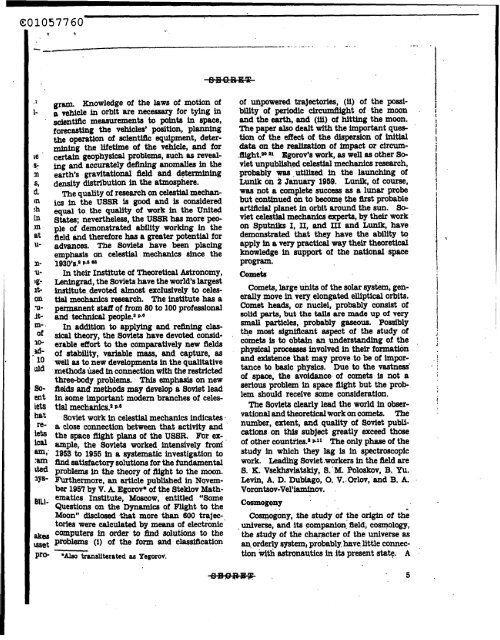4 - The Black Vault
4 - The Black Vault
4 - The Black Vault
You also want an ePaper? Increase the reach of your titles
YUMPU automatically turns print PDFs into web optimized ePapers that Google loves.
e01057760<br />
.i<br />
L-<br />
re<br />
5-<br />
.n<br />
s,<br />
d.<br />
)n<br />
h<br />
[n<br />
)n<br />
at<br />
U-<br />
a-<br />
‘U-<br />
‘e<br />
lton<br />
.v-<br />
.it-<br />
m- .<br />
of<br />
Iod-<br />
10<br />
uld<br />
soent<br />
iets<br />
hat<br />
reieb<br />
ical<br />
-9’<br />
:am<br />
rted<br />
ays-<br />
BILI-<br />
akw<br />
met<br />
Pro-<br />
gr-. Knowledge of the laws of motion of<br />
a vehicle in orbit are necessary for tying in<br />
wtiiic measurements to points in space,<br />
forecasting the vehicles’ position, planning<br />
me operation of sciemtifk equipment, deter-<br />
mining the lifetime of the vehicle, and for<br />
C&&I geophysical problems, such as revealing<br />
and accurately defhhg anomalies in the<br />
earth’s gravitational field and determining<br />
density distribution in the atmosphere.<br />
<strong>The</strong> quality of research on celestial mechanics<br />
in the USSR is good and is considered<br />
equal to the quality of work in the United<br />
states; nevertheless, the USSR has more people<br />
of demonstrated abfltty working in the<br />
fleld and therefore has a greater potentisl for<br />
sdvsnces. <strong>The</strong> Soviets have been placing<br />
emphasis on celestial mechanics since the<br />
193O’s.p P.6<br />
In their Institute of <strong>The</strong>oretical Astronomy,<br />
Leningrad, the Soviets have the world’s largest<br />
institute devoted almost exclusively to celestial<br />
mechanics research. <strong>The</strong> institute has a<br />
permanent stafl of from 80 to 100 professional<br />
and technical pple.z~o<br />
In addition to applying and reflning classical<br />
theory, the Soviets have devoted considerable<br />
eflort to the comparatively new fields<br />
of stability, variable mass, and capture, as<br />
well as to new developments in the qualitative<br />
methods bed in connection with fhe restricted<br />
threebody problems. This emphasis on new<br />
flelds an8 methods may develop a Soviet lead<br />
in some important modern branches of celestial<br />
mechanics.P p-6<br />
Soviet wokk in celestial mechanics indicates<br />
a close connection between that activity and<br />
the space flight plans of the USSR. For example,<br />
the Soviets worked intensively froni‘<br />
1955 to 1955 in a systematic investigation to<br />
find satisfactory solutions for the fundamental<br />
pmblems in the theory of flight to the moon.<br />
Furthermore, an article published in NQvember<br />
1957 by V. A Egorov+ of the Steklov Mathematics<br />
Institute, Moscow, entitled “Some<br />
Questions on the Dynamics of Flight to the<br />
Moon” disclosed that more than 600 trajectories<br />
were calculated by means of electronic<br />
computers in order to i3nd solutions to the<br />
PrOblems (i) of the form and classiAcation<br />
-<br />
‘Also transllterated 88 YegoroV,<br />
of unpowered trajectories, (ii) of the possibility<br />
of periodic circumflight of the moon<br />
and the earth, and (iii) of hitting the moon.<br />
<strong>The</strong> pap& also dealt with the important question<br />
of the effect of the dispersion of initial<br />
data on the realization of impact or circumfflght.m<br />
91 Egorov’s work, as well as other Soviet<br />
unpublished celestial mechanics research,<br />
probably waa utilized in the launching of<br />
Lunik on 2 January 1959. Lunik, of course,<br />
was not a complete success as a lunar probe<br />
but continued on to become the flrst probable<br />
artificial planet in orbit around the sun. Soviet<br />
celestial mechanics experts, by their work<br />
on Sputniks I, II, and III and Lunik, have<br />
demonstrated that they have the ability to<br />
apply in a very practical way their theoretical<br />
knowledge in support of the national space<br />
Prow-.<br />
Corneta<br />
Comets, large uhits of the solar system, generally<br />
move in very elongated elliptical orbits.<br />
Comet heads, 01: nuclei, probably consist of<br />
solid parts, but the tails are made up of very<br />
small particles, probably gaseous. Possibly<br />
the most significant aspect of the study of<br />
comets is to obtain an understanding of the<br />
physical processes involved in their formation<br />
and existence that may prove to be of importance<br />
to basic physics. Due to the vastness<br />
of space, the avoidance of comets is not a<br />
serious problem in space flight but the problem<br />
shouki receive Some consideration.<br />
<strong>The</strong> Soviets Clearly lead the world in observationhl<br />
and theoretical Work on comets. <strong>The</strong><br />
number, extent, and quality of soviet publlcations<br />
on this subject greatly exceed those<br />
of other countries.1 p.ll <strong>The</strong> only phase of the<br />
study in which they lag is in spectroscopic<br />
work. Leaditlg Soviet .workers in the field are<br />
8. K. Vsekhsviatskiy, S. ‘M. Poloskov, B. Yu.<br />
Levin, A. D. Dubiago, 0. V..Orlov, and B. A.<br />
Vorontsov-Vel’iamhov.<br />
Cosmogony<br />
Cosmogony, .the study of the origin oi thi<br />
universe, and its companian. fleld, cosmolagy,<br />
the study of the character of the universe as<br />
an orderly 4ystem, probably have little connection<br />
with astronautics in its present state. A<br />
‘ 5

















